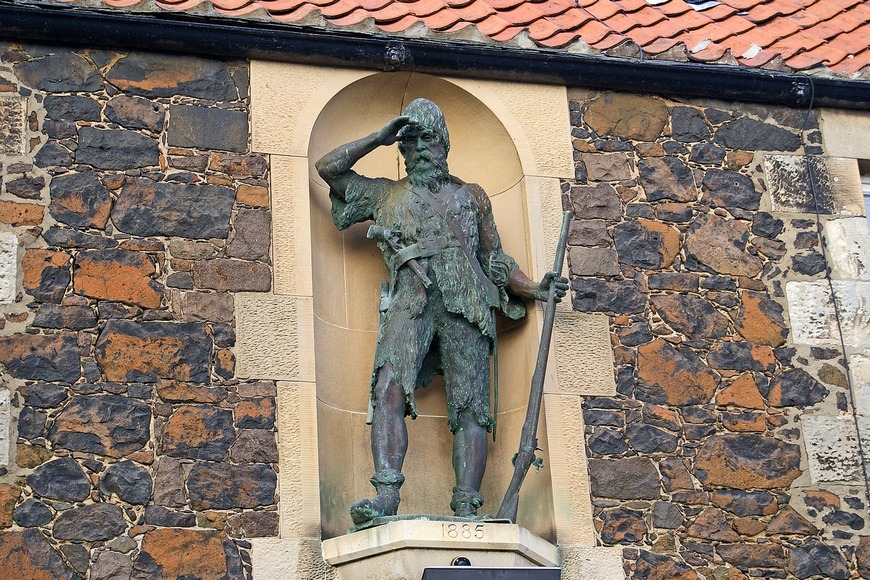Robinson Crusoe by Daniel Defoe

One of the most famous English novels first saw the light of day in April 1719. Its full title was “The Life and Extraordinary and Wonderful Adventures of Robinson Crusoe, a York sailor who lived 28 years alone on a desert island off the American coast near the mouth of the Orinoco River, where he was shipwrecked, in which all the crew except him were killed, and the account of his sudden rescue by pirates; written by himself” was eventually reduced to the name of the protagonist.
The work is based on the true story of the Scottish sailor Alexander Selkirk, who served as bosun on the ship “Sank Por” and was landed in 1704 at his personal request on the uninhabited island of Mas-a-Tierra (Pacific Ocean, 640 kilometers from the coast of Chile). The cause of the misfortune of the real Robinson Crusoe was his intractable nature, the literary – disobedience to his parents, the choice of the wrong path in life (sailor instead of an official in the royal court) and heavenly punishment, which manifested itself in the natural disaster for any traveler – shipwreck. Alexander Selkirk lived on his island for four and a half years, Robinson Crusoe for twenty-eight years, two months and nineteen days.
The time of the novel is September 1, 1651 – December 19, 1686 + that period which the character needs to return home and tell of his unusual adventure. The motif of breaking the parental ban (a parallel to the biblical prodigal son) reveals itself twice in the novel: at the very beginning of the work, Robinson Crusoe, caught up in the swell, repents for what he has done, but the shame of showing his family (including his neighbors) brings him back to the wrong path, which ends in long-term isolation on an uninhabited island. The hero leaves his parents’ home on September 1, 1651; Brazil, where he lives comfortably for the following years, on September 1, 1659. The symbolic warning in the form of a recurring sea storm and the time of the beginning of the adventure turns out to be an insignificant fact for Robinson Crusoe.
Daniel Defoe’s novel is at the origin of the novel genre itself. In terms of its style (simple, precise language, devoid of specific artistic devices) it refers more to the journalistic genre of “travel”, which first appeared in English literature in the 16th century than exactly the literary novel, but the presence of the adventure story, a clearly expressed artistic idea (preservation of humanity in a difficult struggle for life) and character development (growing up Robinson Crusoe, ennobling ogre Friday, repentance pirates) makes it a full literary work. The adventure component gives Robinson Crusoe the features of an adventure novel; the main character’s knowledge of the physical hardships of life points to a novel of education; the character’s difficult journey to settle on an uninhabited island brings the work closer to an allegorical parable about the development of human civilization; the novel’s exotic elements for the English environment (distant countries, sea voyages, wild animals, ogres and pirates) make it a classic adventure novel. Robinson Crusoe was originally created for adult readers, but over time it naturally moved into the circle of children’s reading.
The main idea of the work – the spiritual and intellectual maturation of a young man, put in the unique conditions of life. Robinson Crusoe begins his life journey on a desert island with a minimum of knowledge about the device of things necessary for survival and a basic set of the latter. Some of the items the hero has to make his own. He does not mind spending time on this, as he realizes that the latter, as well as his “labor was very cheap, so do not care what and where they went?
Vital things (ship boards, food supplies, clothing, carpenter’s tools, knives, weapons, gunpowder, etc.) are contrasted with money in the novel. Robinson Crusoe sees the latter as “worthless trash”: on an island devoid of people and merchants’ shops, they are useless. However, the hero nevertheless wraps the gold found on the ship in a piece of sailcloth and takes it with him to the island. The action is in no way explained by him, but the reader understands that it is dictated by the hope of returning to the bosom of civilization.
In addition to his factory art (making a smoking pipe, baskets, fur clothing, etc.), Robinson Crusoe learns the trades of farmer and herdsman on the island: he quickly realizes that he cannot survive long on the ship’s provisions, so he begins gathering turtle eggs and grapes, taming the wild goats, growing rice and barley.